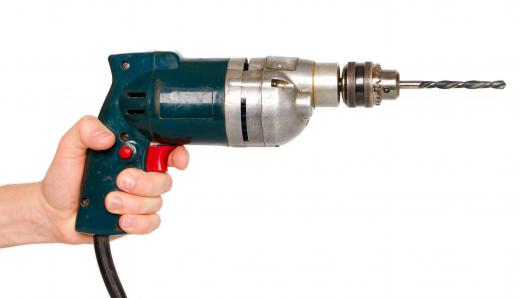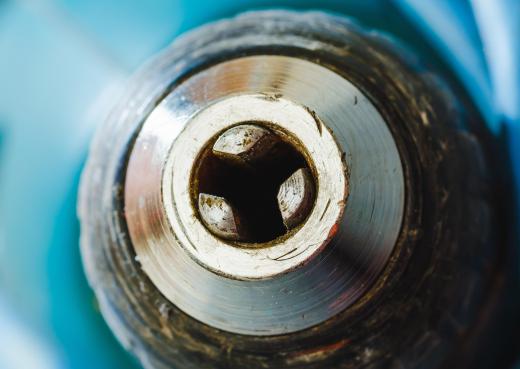Drilling machines are tools that have a rotating, cutting component at one end that bores holes into different materials. There are several types of drilling machines that may be used for a wide variety of purposes, including woodworking, construction, masonry, metalworking, medicine, oil drilling, and many other fields. Common drills include the hand drill, push drill, pistol-grip drill, hammer drill, and drill press. In addition to making holes, drills are often used to push screws into wood, metal, plastic, rock, or composites.
The hand drill and push drill are both manually operated drilling machines that have been largely replaced by power drills. A hand drill works by turning a crank that rotates gears, which cause the chuck to turn. The chuck is the component of the drilling machine that holds the bit, or the end cutting piece. The push drill is a skinny tool resembling a screwdriver with a handle that can be pushed down on a threaded shaft, or a pole with helical ridging. As the handle is pushed down along threading, the shaft, chuck, and bit spins downward, much like pumping a toy metal top.

Pistol-grip drills are the most commonly used drilling machines. These are corded electric drills that are typically shaped roughly like a pistol, with a trigger switch that starts a motor inside the drill. The motor causes the chuck and bit to spin in continuous revolutions. These drilling machines may be used to make holes for bolts or other purposes, to push screws into wood, plastic, or other materials, and to bore countersinks. A countersink is a screw-shaped hole that is made before the screw is drilled in, preventing splintering or pulling of the plastic or wood around the head of the screw.

A pistol-grip drill is also available in a battery-powered, cordless version, though they are usually more expensive. There are many different types of this drill and several indications for use. It is also possible to adapt the drill with an attachment, such as sanding or sawing components.
A hammer drill, also called a rotary hammer, is similar to a pistol-grip drill, but also applies a punching motion to complement the rotational action of the bit. This hammering, forward force makes it useful for tougher materials, such as concrete or stone, that standard electric drills cannot cut through. For softer materials, however, the hammer drill may apply excessive force and a standard drill may be a better choice.

A drill press is a type of drill that may stand on the floor or be mounted on a workbench. The base of the machine is bolted to the table or floor and a column rises up from the base to support the back of the head of the drill. The column also supports a table that can be adjusted in height between the head and the base.
The spindle, a metal component that holds the chuck and drill bit, extends downward from the front of the head, parallel to the column. A larger distance between the spindle and column allows wood with a larger width to be drilled. An “on” switch triggers the spindle to spin and levers attached to the head of the drill press move the spindle and chuck to move up or down. These drilling machines are suited for accurate drilling, because the bit is fixed and the work can be secured to the table with clamps or a vise.
